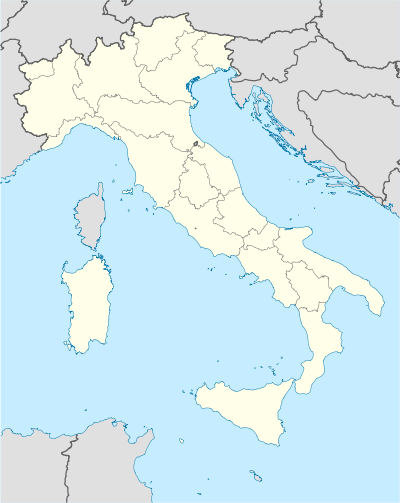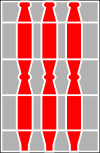Gubbio
| Gubbio | |||
|---|---|---|---|
| — Comune — | |||
| Città di Gubbio | |||
 |
|||
|
|||
 Gubbio
|
|||
| Coordinates: | |||
| Country | Italy | ||
| Region | Umbria | ||
| Province | Perugia (PG) | ||
| Frazioni | see list | ||
| Government | |||
| - Mayor | Orfeo Goracci (Communist Refoundation Party) | ||
| Area | |||
| - Total | 525 km2 (202.7 sq mi) | ||
| Elevation | 522 m (1,713 ft) | ||
| Population (31 May 2007) | |||
| - Total | 32,674 | ||
| - Density | 62.2/km2 (161.2/sq mi) | ||
| Demonym | Eugubini | ||
| Time zone | CET (UTC+1) | ||
| - Summer (DST) | CEST (UTC+2) | ||
| Postal code | 06024, 06020 | ||
| Dialing code | 075 | ||
| Patron saint | St. Ubaldus | ||
| Saint day | May 16 | ||
| Website | Official website | ||
Gubbio is a town and comune in the far northeastern part of the Italian province of Perugia (Umbria) It is located on the lowest slope of Mt. Ingino, a small mountain of the Apennines. See also Mount Ingino Christmas Tree.
Contents |
History
The city's origins are very ancient. The hills above the town were already occupied in the Bronze Age (Malone and Stoddart 1994). As Ikuvium, it was an important town of the ancient Umbrian people in pre-Roman times, made famous for the discovery there of the Eugubine (or Iguvine) Tables, a set of bronze tablets that together constitute the largest surviving text in ancient Umbrian. After the Roman conquest in the 2nd century BC — it kept its name as Iguvium — the city remained important, as attested by its Roman theater, the second-largest surviving in the world.
Gubbio became very powerful in the beginning of the Middle Ages. The town sent 1000 knights to fight in the First Crusade under the lead of count Girolamo Gabrielli, and according to an undocumented local tradition, they were the first to penetrate into the Holy Sepulchre when the city was seized (1099).
The following centuries were quite turbulent, and Gubbio was engaged in wars against the surrounding towns of Umbria. One of these wars saw the miraculous intervention of its bishop, Saint Ubaldo Baldassini, who secured Gubbio an overwhelming victory (1151) and a period of prosperity. In the struggles of Guelphs and Ghibellines, the Gabrielli, such as the condottiero Cante de' Gabrielli da Gubbio (c.1260-1335), were of the Guelph faction, supportive of the papacy; as Podestà of Florence, Cante exiled Dante Alighieri, ensuring his own lasting notoriety,
In 1350 Giovanni Gabrielli, count of Borgovalle, a member of the most prominent noble family of Gubbio, seized communal power and became lord of Gubbio. However his rule was short, and he was forced to hand over the town to Cardinal Albornoz, representing the Church (1354).
A few years later, Gabriello Gabrielli, bishop of Gubbio, proclaimed himself again lord of Gubbio (Signor d’Agobbio). Betrayed by a group of noblemen which included many of his relatives, the bishop was forced to leave the town and seek refuge at his home castle at Cantiano.
With the decline of the political prestige of the Gabrielli family, Gubbio was thereafter incorporated into the territories of the Montefeltro. Federico da Montefeltro rebuilt the ancient Palazzo Ducale, incorporating in it a studiolo veneered with intarsia like his studiolo at Urbino.[1] The maiolica industry at Gubbio reached its apogee in the first half of the 16th century, with metallic lustre glazes imitating gold and copper.
Gubbio became part of the Papal States in 1631, when the family della Rovere, to whom the Duchy of Urbino had been granted, was extinguished. In 1860 Gubbio was incorporated into the Kingdom of Italy along with the rest of the Papal States.
Main sights
The historical center of Gubbio is of decidedly medieval aspect: the town is austere in appearance because of the dark grey stone, narrow streets, and Gothic architecture.
A fair number of the houses in Gubbio date to the 14th and 15th centuries, and were originally the dwellings of wealthy merchants; they often have a second door fronting on the street, usually just a few inches from the main entrance. This secondary entrance is narrower, and a foot or so above the actual street level. This type of door is called a porta dei morti (door of the dead) because it is commonly stated that it was used only for removing the bodies of any who might have died inside the house. This is almost certainly false, but there is no firm agreement on the true purpose of the secondary doors. One of the most likely theories is that the door was used by the owners to protect themselves when opening to unknown persons, leaving them in a dominating position.
The main monuments and sightseeings of the city include:
- The Roman Theatre, built in the 1st century BC using square blocks of local limestone. Originally, the diameter of the cavea was 70 meters. During summer it is used for lectures about ancient poets and authors.
- The Roman Mausoleum (sometimes said to be of Pomponius Graecinus, but on no satisfactory grounds)
 Palazzo dei Consoli.
Palazzo dei Consoli. - The massive Palazzo dei Consoli (first half of the 14th century), housing the museum with the Eugubine Tables.
- The Palazzo and Torre Gabrielli
- The Duomo (Cathedral), built in the late 12th century. The most striking feature is the rose-window in the facade with, at its sides, the symbols of the Evangelists: the eagle for St. John, the lion for St. Mark, the angel for St. Matthew and the ox for St. Luke. The interior has latine cross plan with a single nave. The most precious art piece is the wooden Christ over the altar, of Umbrian school.
- The Palazzo Ducale, built from 1470 by Luciano Laurana or Francesco di Giorgio Martini for Federico da Montefeltro. Famous is the inner court, reminiscent of the Palazzo Ducale of Urbino.
- The Church of S. Francesco (second half of the 13th century), the sole religious edifice in the city having a nave with two aisles. The vaults are supported by octagonal pilasters. The frescoes in the left side date from the 15th century.
- The Church of Santa Maria Nuova, a typical Cistercian edifice of the 13th century. In the interior is a 14th century fresco portraying the so-called Madonna del Belvedere (1413), by Ottaviano Nelli. It also has a work by Guido Palmerucci. Also from the Cistercians is the Convent of St. Augustine, with some frescoes by Nelli.
- The Basilica of Sant'Ubaldo, with a nave and four aisles is a sanctuary outside the city. Noteworthy are the marble altar and the great windows with episodes of the life of St. Ubaldo, patron of Gubbio. The finely sculpted portals and the fragmentary frescoes give a hint of the magnificent 15th century decoration once boasted by the basilica.
- The Museo Cante Gabrielli in the Palazzo del Capitano del Popolo (which once belonged to the Gabrielli).
- The Vivian Gabriel Oriental Collection of Tibetan, Nepalese, Chinese and Indian art. The collection was donated to the municipality by Sir Edmund Vivian Gabriel (1875-1950), British colonial officer and adventurer, collateral descendant of the Gabrielli who were lords of Gubbio in the Middle Ages.
Culture

Gubbio is best known for its palio, the Corsa dei Ceri, a spectacular run held every year on May 15, in which three teams, devoted to S. Ubaldo (the patron saint of Gubbio), S. Giorgio, and S. Antonio, run through throngs of cheering supporters (clad in the distinctive colours of yellow, blue and black, with white trousers and red belts and neckbands), up much of the mountain from the main square in front of the Palazzo dei Consoli to the basilica of S. Ubaldo, each team carrying a statue of their saint mounted on a wooden octagonal prism, similar to an hour-glass shape 4 meters tall and weighing about 280 kilograms.
The race has strong devotional, civic, and historical overtones and is one of the best-known folklore manifestations in Italy; the Ceri were chosen as the heraldic emblem on the coat of arms of Umbria as a modern administrative region.
A celebration like the Corsa dei Ceri is held also in Jessup, Pennsylvania. In this small town the people carry out the same festivities as the residents of Gubbio do by "racing" the three statues through the streets. This remains an important and sacred event in both towns.
Gubbio was also one of the centres of production of the Italian pottery (maiolica), during the Renaissance. The most important Italian potter of that period, Mastro Giorgio, was active in Gubbio during the early 16th century.
The city is the setting for the popular story of St. Francis and the Wolf of Gubbio, recorded in the medieval Fioretti di San Francesco.
Frazioni
The frazioni (territorial subdivisions) of the comune of Gubbio are: Belvedere, Biscina, Branca, Burano, Camporeggiano, Carbonesca, Casamorcia-Raggio, Cipolleto, Colonnata, Colpalombo, Ferratelle, Loreto, Magrano, Mocaiana, Monteleto, Monteluiano, Nogna, Padule, Petroia, Ponte d'Assi, Raggio,San Benedetto Vecchio, San Marco, San Martino in Colle, Santa Cristina, Scritto, Semonte, Spada, Torre Calzolari and Villa Magna.
The Gubbio Layer
Gubbio is also famous among geologists and palaeontologists as the discovery place of what was at first called the "Gubbio layer", a sedimentary layer enriched in iridium that was exposed by a roadcut outside of town. This thin, dark band of sediment marks the K–T boundary, between the Cretaceous and Tertiary geological periods roughly 65 million years ago, and was formed by infalling debris from the gigantic meteor impact responsible for the mass extinction of the dinosaurs. Its iridium, a heavy metal rare on Earth's surface, is plentiful in extraterrestrial material such as comets and asteroids. It also contains small globules of glassy material called tektites, formed in the initial impact. Discovered at Gubbio, the K–T boundary is also visible at many places all over the world. The characteristics of this boundary layer support the theory that a devastating meteorite impact, with accompanying ecological and climatic disturbance, was directly responsible for the Cretaceous-Tertiary extinction event.
In fiction
The protagonist of Herman Hesse's Steppenwolf - an isolated and tormented German intellectual of the 1920s - consoles himself in one scene by recalling beautiful and inspiring things he had seen. Among these is mentioned "(...) That slender cypress on the hill over Gubbio that, though split and riven by a fall of stone, yet held fast to life and put forth with its last resources a new sparse tuft at the top" [2].
The passage might refer to an actual tree seen by the writer, who is known to have extensively traveled in Italy.
The town is also referenced in Antal Szerb's Journey by Moonlight.
Twin towns
 Thann, France
Thann, France Salon-de-Provence, France
Salon-de-Provence, France Wertheim, Germany
Wertheim, Germany Jessup, USA
Jessup, USA Sassari, Italy
Sassari, Italy
References
Malone, C. A. T. and Stoddart, S. K. F. (eds.). 1994. Territory, Time and State. The archaeological development of the Gubbio basin. Cambridge, Cambridge University Press.
- ↑ The Gubbio studiolo is reassembled in its entirety at the Metropolitan Museum of Art; Federico's father, Guidobaldo da Montefeltro, and his daughter Agnese da Montefeltro were born in Gubbio.
- ↑ Herman Hesse, Steppenwolf, chapter 1. ("For Madmen Only")
External links
- Official Site
- Gubbioweb.it - Gubbio Web Portal
- Official site of the Festa dei Ceri
- GUBBIO on: Associazione Eugubini nel Mondo
- Umbria Online
- Thayer's Gazetteer
- Umbria Travel:Gubbio
- Rugby Gubbio - Official Web Site
- Paradoxplace Gubbio Photo Pages
- Sbandieratori di Gubbio (flag-wavers, flag-throwers)
|
|||||||

